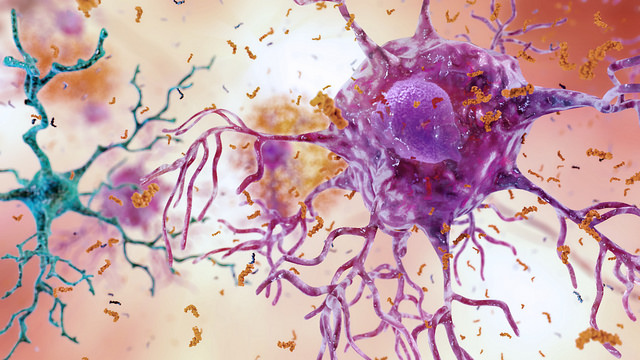Neurodegenerative illnesses are a devastating category of diseases affecting millions of people on a global scale. These diseases affect the way that individual neuron cells respond to stimuli in the spine and brain. Without neuron stimuli, cells in the spine and brain can eventually experience loss of function, deterioration, and death. As a result, people suffering from neurodegenerative diseases can experience progressively worsening symptoms, ranging from coordination and memory issues to difficulty walking or thinking clearly.
 Since the most prevalent neurodegenerative diseases—Alzheimer’s disease and Parkinson’s disease—tend to affect individuals in middle or late life, the number of cases of these diseases has increased over the years. Scientists believe that over 12 million Americans could suffer from a neurodegenerative disease by 2050. As numbers continue to rise, researchers have increased focus on the bodily mechanisms behind these diseases.
Since the most prevalent neurodegenerative diseases—Alzheimer’s disease and Parkinson’s disease—tend to affect individuals in middle or late life, the number of cases of these diseases has increased over the years. Scientists believe that over 12 million Americans could suffer from a neurodegenerative disease by 2050. As numbers continue to rise, researchers have increased focus on the bodily mechanisms behind these diseases.
Protein Accumulation
Research has shown that neurodegenerative diseases are caused by clumps of protein that accumulate and build up in the brain and spinal cord. Over time, these clumps are thought to contribute to cell death and lead to significant brain changes that affect the way the mind and body function. Two specific protein types—tau proteins and amyloid proteins—are the focus of the majority of Alzheimer’s and Parkinson’s research.
However, what isn’t clear is precisely how these protein clumps lead to cell death, or which types of proteins—tau or amyloid-beta—may be the main drivers behind the disease’s beginnings. As a result, many studies are devoted to discovering the triggers that cause the beginning of cell degradation. Two such studies have recently identified a potential alternative target for neurodegenerative disease therapies.
The Role of Proteasomes
These studies, performed by scientists at Rockefeller University, focus on proteasomes—protein complexes that contain protease, which breaks down proteins. Neurons form proteasomes inside the cell body and assist the neurons in breaking down amyloid buildup. If these proteasomes cannot reach the nerve endings in the body and properly break down proteins, the cell can experience protein buildup and struggle to function correctly.
Due to these findings, Herman Steller of Rockefeller’s Strang Laboratory of Apoptosis and Cancer Biology believes that the process of protein aggregation may not be the best research target to focus on. Instead, he believes that amyloid buildup and tau aggregation do not cause neurodegenerative disease but are a symptom of proteasome malfunction. For this reason, he thinks that proteasome malfunction may be better to focus on to help fight neurodegenerative disease.
Ongoing Research
The Rockefeller University studies identified a specific protein in fruit flies called PI31 that helps load proteasomes onto cellular pathways and move them toward the nerve endings. When PI31 production was inhibited, the movement of proteasomes stopped. After a second study highlighted the same issue in mice, researchers noticed that abnormal protein accumulations were developing at the tips of nerve endings, causing strange changes in cell behavior. These changes became increasingly severe with age, which is also a key component of the cell changes found in Alzheimer’s and Parkinson’s.
While Steller believes that neurodegenerative diseases begin with defects in proteasomes, much research is still needed to prove that protein aggregation is an effect of neurodegeneration rather than the cause. If true, PI31 and the molecules that transport it may be potential drug targets. As research continues, the knowledge about the mechanisms that cause neurodegenerative disease—and therapies designed to combat them—continues to grow and provides hope for the millions of people dealing with these diseases on a day-to-day basis.
Sources:
https://www.beingpatient.com/brain-process-amyloid-buildup/
https://neurodiscovery.harvard.edu/challenge
https://www.niehs.nih.gov/research/supported/health/neurodegenerative/index.cfm
https://www.pnas.org/content/116/49/24639
https://www.cell.com/developmental-cell/fulltext/S1534-5807(19)30527-1

 Tips for Having a Happy and Healthy Holiday Season
Tips for Having a Happy and Healthy Holiday Season